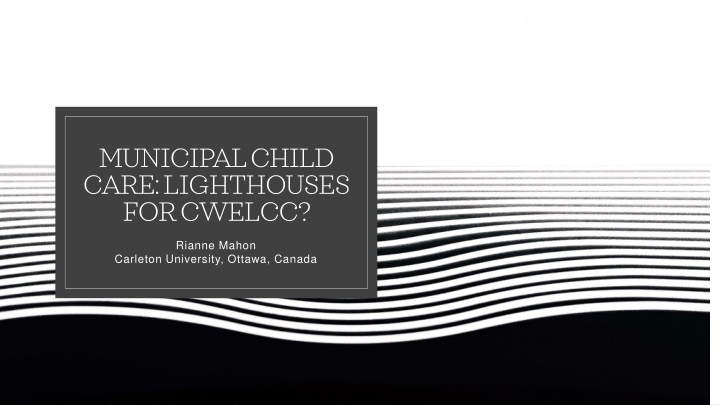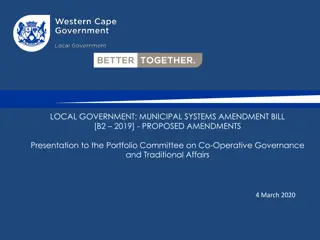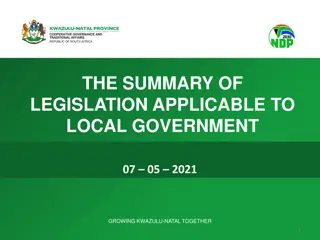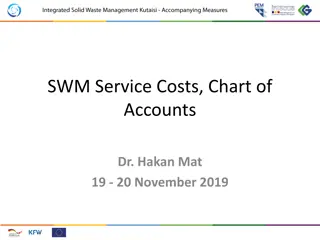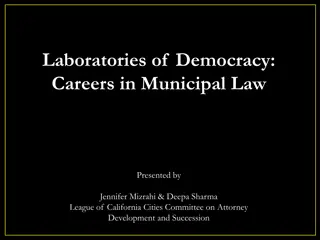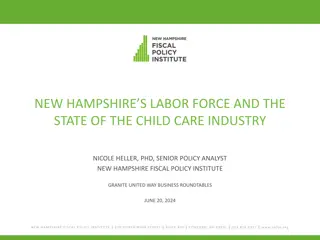Municipal Child Care: Lighthouses for CWELCC
Municipal provision of child care can be a guiding light for the sector in Canada, offering learning opportunities and enhancing quality. Toronto's Early Learning and Child Care Services serve as an example of this model, showcasing how municipal involvement can contribute to affordable and high-quality child care. While current municipal involvement varies across provinces, initiatives like the Kipling ELCC highlight innovative approaches to early learning and intergenerational programming. Explore the potential role of municipalities in shaping the child care landscape in Canada.
Download Presentation

Please find below an Image/Link to download the presentation.
The content on the website is provided AS IS for your information and personal use only. It may not be sold, licensed, or shared on other websites without obtaining consent from the author.If you encounter any issues during the download, it is possible that the publisher has removed the file from their server.
You are allowed to download the files provided on this website for personal or commercial use, subject to the condition that they are used lawfully. All files are the property of their respective owners.
The content on the website is provided AS IS for your information and personal use only. It may not be sold, licensed, or shared on other websites without obtaining consent from the author.
E N D
Presentation Transcript
MUNICIPAL CHILD CARE: LIGHTHOUSES FOR CWELCC? Rianne Mahon Carleton University, Ottawa, Canada
The argument in brief Municipal provision of child care can play an important role in achieving expansion of affordable, quality child care across Canada. Though unlikely to become dominant, municipal child care centres can function as a kind of navigational lighthouse for the sector as a whole and a learning opportunity for the provinces. Toronto Early Learning and Child Care Services (TELCCS) as example. Not only in Toronto: there are important beacons in much smaller centres. Provinces can facilitate this (e.g. BC) but also work to impede (recent Ontario initiatives).
Current municipal involvement in child care provision None in Newfoundland, Nova Scotia, Quebec and Manitoba. Newfoundland in fact currently prohibits this, but policy may change. PEI has 2, New Brunswick 3, Saskatchewan 3, Alberta 4, BC 63 and Ontario 109. Even in the latter account for a very small percentage of the total. Municipally run child care been decreasing. Alberta once had municipal lighthouse centres in Calgary, Edmonton, Medicine Hat and Red Deer. All gone in 1990s. In 1998 municipal centres accounted for 18% of child care centres in Ontario. Now down to 2% following closures in cities like Windsor, Peel, Waterloo.
Pioneer Lighthouse: Toronto Early Learning and Child Care Accounts for only 3% of all spaces, but 10% of infant spaces. Concentrated in low income and vulnerable communities Emergency capacity (e.g. COVID) and system stability as able to step in when commercial or non-profit centres close (Weston, Kingston Rd, Mount Dennis) High quality jobs with fair wages and good benefits, benchmark for rest of sector Highly qualified staff benefit from more professional development hours than rest of the sector, including training in mental health, 2SLGBTQ+, anti-racism Pilot new initiatives before scaling up to implementation across the sector Support administration, human resources, operations, quality concerns and training in the wider community-based child care sector.
An interesting example: Kipling ELCC The Centre shares location with Kipling Acres Long-Term Care to facilitate intergenerational programming. Results in collaborative activities such as children deliver mail to residents and residents visiting the centre. Centre recognised as outstanding design model for early learning and child care space with low window benches, a welcoming entrance area with book-lending library. Outdoor space redesigned into an intergenerational garden area Often visited by others interested in its physical space and unique programming.
Not only in Toronto: Rainy River, Ontario District Social Services Admin Board responsible for 15,000 square km but population of only 20,000. Faced with challenge of introduction of full-day kindergarten for 4 and 5 year olds, chose single public governance for its 9 child care centres. Facilities costs and other admin savings allow the DSSAB to approach compensation rates of ECEs working in full day kindergarten. As employees also part of pension and benefit plans. ECEs of school-age children deployed throughout the system, avoiding split shifts. District working to remove barriers for parents with non-standard schedules (many in district have 12 hour days with 4 days on, 4 days off).
Russell Township, Ontario District located south-east of Ottawa with a population density 98.6 square km. Municipality took over operation of 1 closed and 1 struggling for profit centre and expanded them to add 456 new spaces Improved compensation including eligibility for pensions and benefits Helping on graduate educators with the cost of schooling toward Registered ECE designation. Working with local college to design in- service training
Drayton Valley, Alberta population 7000 Developed a plan to establish a publicly delivered child care facility to attract families of oil sands workers Staff are paid union rates and are employees of the town. Most meet Alberta maximum qualification requirements. Shares operating policies, procedures and related documentation with other centres. When a new centre is being developed in the region, the centre manager is often asked to provide support and mentorship.
What role can provinces play: The Good: British Columbia Province introduced two new provincial funds in cooperation with the Union of BC Municipalities: Child Care Community Planning program administers grants enabling communities to develop child care space creation plans. Develops local capacity while improving provincial knowledge. Community Child Care Space Creation program provides local governments up to $1 million to create new licensed child care spaces for children aged 0-5. Under the latter, priority for programs directly operated by the local government or public sector organisation for underserved populations and non-standard hours child care
The Bad: Current Ontario policies The only province to mandate a role for municipalities, but Ontario currently moving backward. Current gov t passed regulations eliminating municipal discretion about which centres should be preferred to provide subsidised services. Previously 16 had decided to only sign with non-profit providers. All municipal child care programs now required to undergo audits to determine whether the services could be offered by a 3rdparty provider instead. Service System Managers are required to ensure opportunities for community- based delivery participation are exhausted before direct child care delivery by the Consolidated Municipal Service Managers/District Soc Services Admin Bds.
Conclusions Although they are not signatories to the federal-provincial CWELCC agreements, municipalities can play an important role in expanding affordable, quality child care across Canada. They can create high quality, innovative centres offering equitable wages and good working conditions and thus function as lighthouses Provincial governments can impede this or they can follow BC s good example and support not only municipal planning but also child care provision.
Sources consulted M. Friendly, J Beach, S. Mohamed, L. Rothman, R. Vickerson, C. A. Young, (2020) Moving from Private to Public Processes to Create Child Care in Canada CRRU M. Friendly, G. Cleveland, S. Colley, C. Holt, R. Vickerson and C. Ferns (2023) The Municipal Role in Child Care IMFG Who Does What Series No. 8 OISE and George Brown College (2021) Review of Toronto Early Learning and Child Care Services: Their Unique Contribution to Toronto s Equity, Inclusion and Poverty Reduction Goals Community and Social Services Toronto
